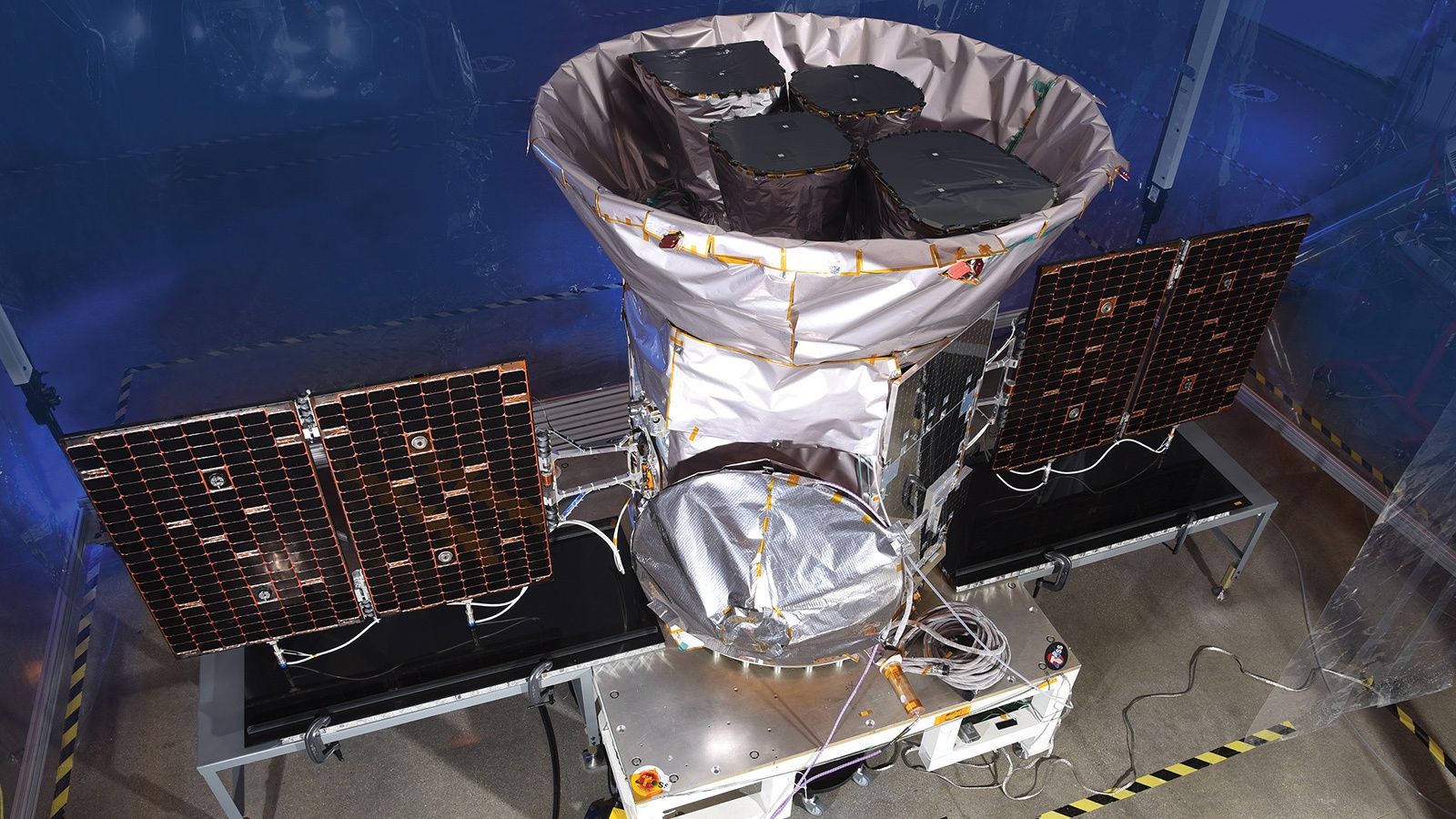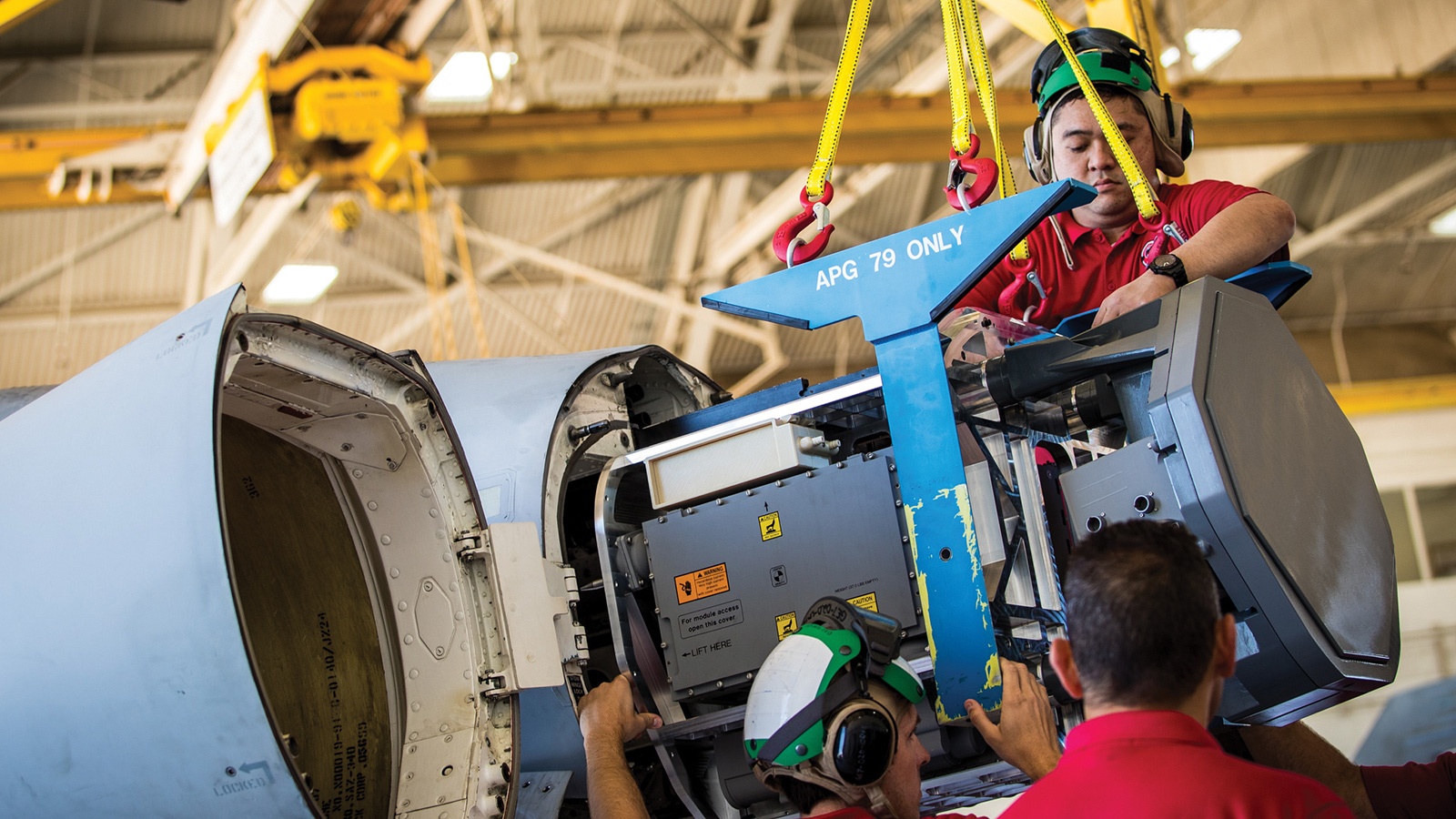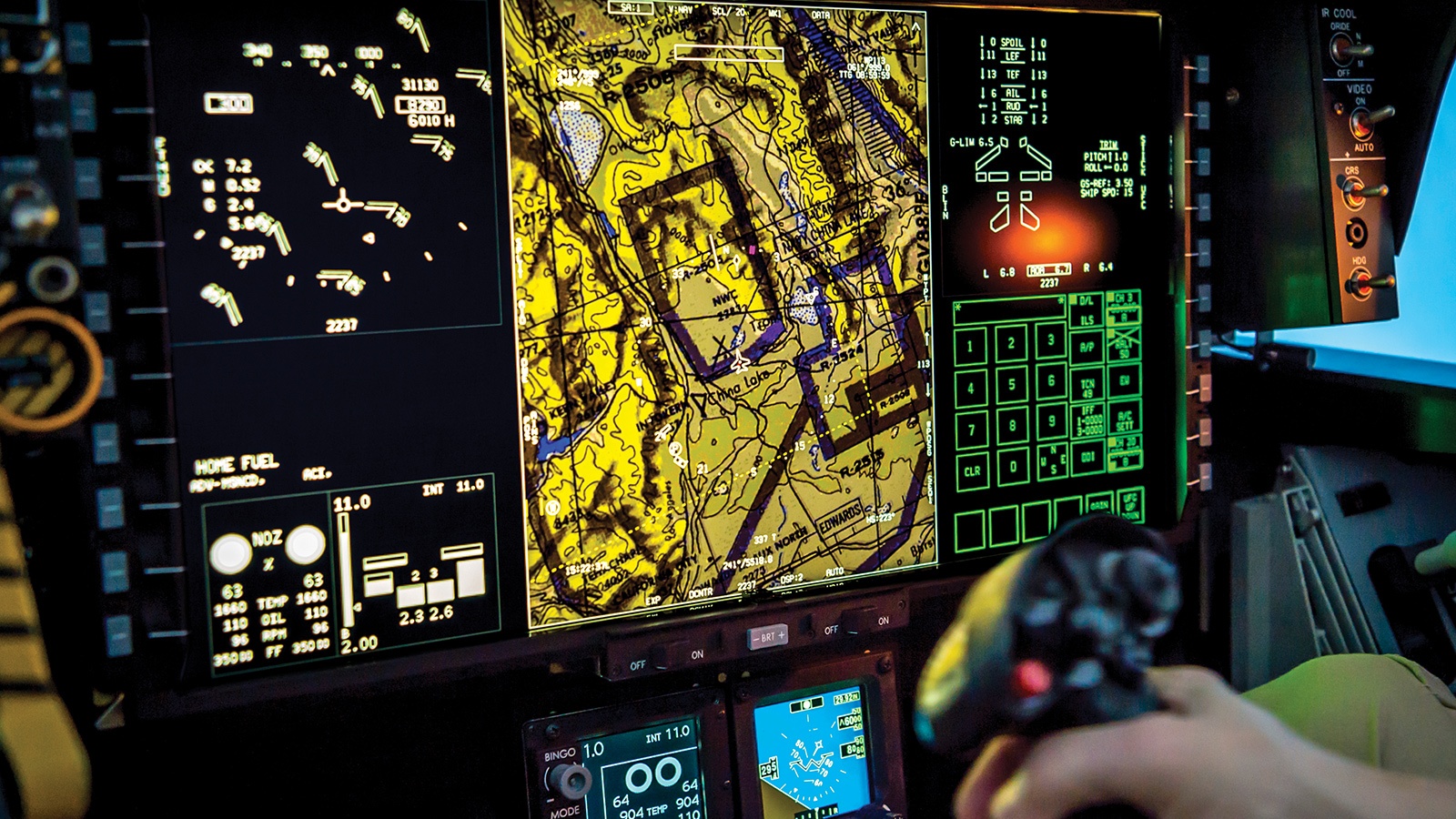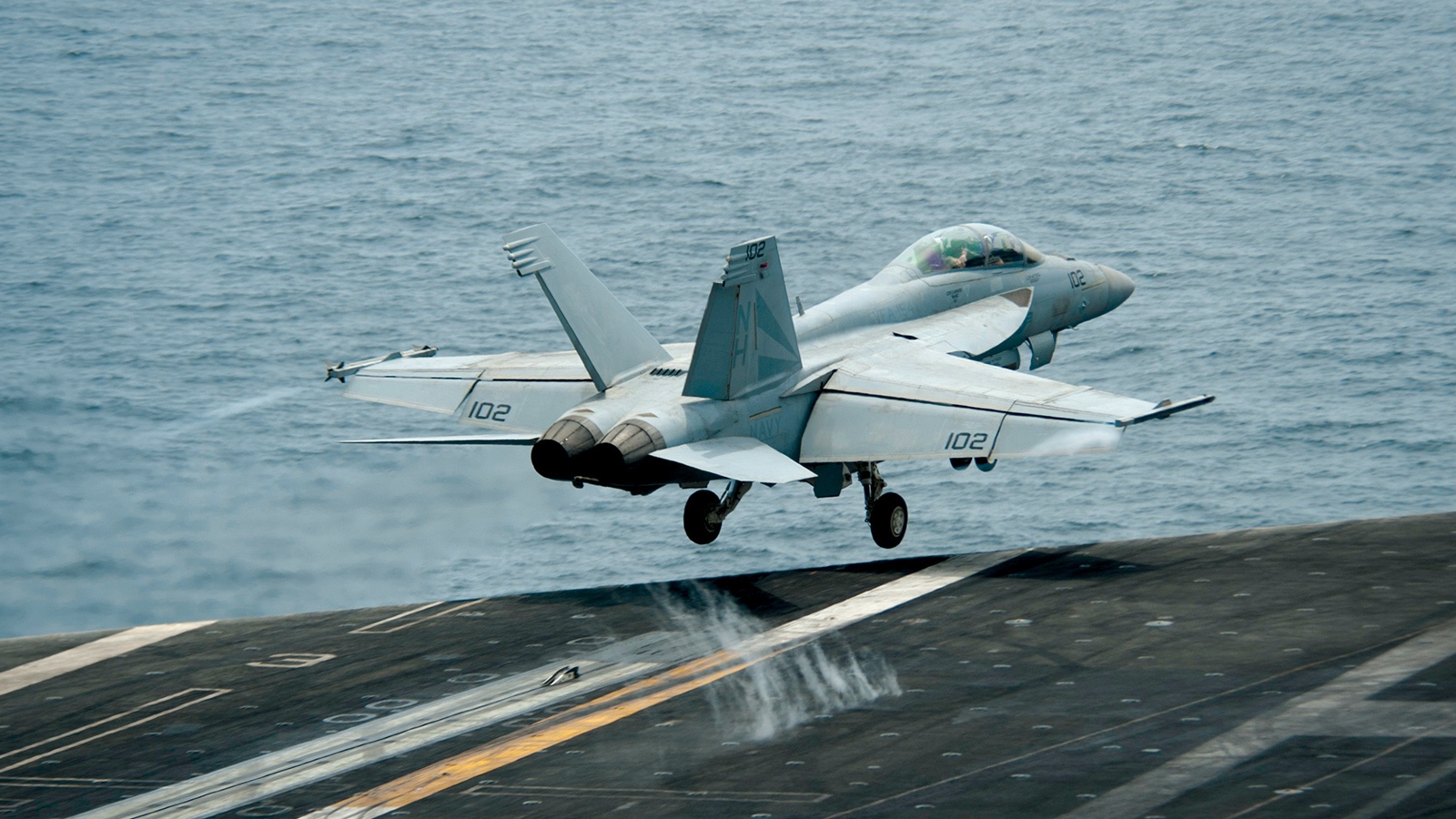Stay Up to Date
Submit your email address to receive the latest industry and Aerospace America news.
In a handful of incidents that go back to 2004, U.S. Navy fighter pilots and weapons officers have reported detecting strange objects maneuvering quickly with unheard of agility around their aircraft. The Navy professes to be as mystified as anyone. Jan Tegler and Cat Hofacker went searching for possible explanations. Here is what they found.
During training flights off the East Coast of the U.S. in 2014 and 2015, unidentified gauzy blobs showed up on the cockpit displays of F/A-18 jets so often that U.S. Navy pilots gave them a nickname. “Usually we’d just say, ‘we’re seeing one of those damn things again,’” Ryan Graves, a former Navy lieutenant and F/A-18F pilot, told us in a September phone interview.
Graves is one of three F/A-18 pilots who have publicly described encounters with small, featureless objects that, depending on the account, descended and ascended with incredible mobility before accelerating and vanishing. Graves and colleagues were not the first to see mysterious objects on their cockpit displays or, in at least two other reported cases, with human eyes. The first sighting, as far as the public record shows, occurred in 2004 when a pilot reported seeing a fast-moving object about 40 feet (12 meters) long whose shape resembled, of all things, a Tic Tac mint.
The U.S. Navy this year began publicly emphasizing how seriously it is taking such accounts by its flyers. The Navy’s determination to help solve the mystery is understandable, given that each of the possible explanations that we explore in this article is unsettling in its own way.
Spearheading the Navy’s investigation is the Office of the Deputy Chief of Naval Operations for Information Warfare, where the job is to make sure the Navy outperforms its adversaries on the intelligence, cyberspace and electronic warfare fronts. Representatives of the office began fanning out to the service’s F/A-18 strike fighter squadrons earlier this year “to encourage our aviators to report any observations of UAPs.” That’s shorthand for unidentified aerial phenomena. The Pentagon borrowed the term from the United Kingdom partly because the phrase does not “pre-judge the results of any investigation,” the office of the DCNO for Information Warfare says. The Navy declined to discuss the direction of its investigation, but the word “phenomena” to us suggests that the Navy wants to leave open the possibility that whatever the pilots are seeing might not be objects at all. The term also handily sidesteps the culturally freighted term “UFO.”
We are deeply curious about possible explanations for the sightings, and so we conducted our own investigation. The Navy declined our request to interview its investigators, so we sent written questions. We also interviewed Graves, other current and former Navy pilots, a military analyst and scientists.
It’s not E.T. — we don’t think
Because we know it’s on all our minds, let’s first consider the unlikely but gobsmacking possibility of extraterrestrial visitation.
From what exoplanet scientists know at this time, a giant leap of faith would be required to conclude that humanity is not alone. As of October, NASA’s Exoplanet Archive lists 4,073 confirmed exoplanets identified by scouring graphs of star intensities gathered mainly by NASA’s Kepler space telescope before its mission ended in 2018 and now also its successor TESS, short for Transiting Exoplanet Survey Satellite. When the intensity of a star dips slightly and at regular intervals, this indicates that a planet is passing in front of the star.
Astronomers believe 55 of those exoplanets could be habitable, because each orbits its star at a distance that makes the surface temperatures right for liquid water. The term “habitable” does not tell us whether life exists, or if it does, whether the life consists of microbes or a civilization. If we assume that intelligent life requires conditions similar to those on Earth, proving the existence of those conditions would require direct observations of the planet’s atmosphere, probably with the aid of a coronagraph inside a space telescope or a free-flying starshade positioned ahead of the telescope to block the blinding light from the host star. Those technologies are still years away from deployment.
That’s where matters stand today, but in fairness, astronomers are just at the beginning of their exoplanet hunt. Consider the Drake equation created in 1961 by astronomer Frank Drake of California, now an emeritus trustee at the Search for Extraterrestrial Intelligence, or SETI, Institute he co-founded in 1984. His equation estimates how many communicating civilizations might exist in our galaxy. Astronomers feed variables into the equation, including what’s known about the rate of star formation in the Milky Way and estimates of the number of stars hosting planets that could support life. The Drake equation has spit out numbers ranging from thousands of communicating civilizations to none. “Each number might as well come with an asterisk next to it, given how little we really know about our own galaxy, let alone the universe,” says astrophysicist Erin Macdonald, host of “Dr. Erin Explains the Universe” on YouTube. “That said, it’s still good to think of all the probabilities that would need to be considered to assess the possibility of life, so as a thought experiment, it’s a great start.”
That still leaves the distance problem. Kepler stared at star systems up to 3,000 light-years away, and only a handful of the confirmed exoplanets are less than 100 light-years from Earth. The closest exoplanet, spotted in 2016 by telescopes at the La Silla Observatory in Chile, is Proxima b at 4.2 light-years away. Assume that a spacecraft equivalent to NASA’s Parker Solar Probe, which is the fastest human-made object, were to leave Proxima b tomorrow. It would need at minimum 6,500 years to reach Earth.
Crossing such a vast distance would require traveling at close to the speed of light or finding a shortcut through space-time.
In any case, scientists are not optimistic that Proxima b is a good candidate for life, even though it’s within its star’s habitable zone. The planet has been subjected to “much harsher radiation than the Earth ever was,” says astrophysicist Scott Engle of Villanova University in Pennsylvania, who’s published papers on the planet’s habitability. That’s not to entirely rule out life: “It’s also possible that higher radiation could challenge life and through natural selection it could have evolved to adapt,” Engle says.
He has watched the mysterious objects in the videos “perform aerial maneuvers that would be impossible to do with anything we have,” but he still doesn’t buy that we’ve been E.T-ed. He can’t see a motive: “Why are they doing this?”
Still, the idea of visitation has tantalized even the staid and cautious defense industry. We contacted Raytheon, hoping to learn whether one of the company’s executives was serious in a 2017 press release when he said that the Raytheon-made video targeting pod on a Navy F/A-18 Super Hornet “might be the system that caught the first evidence of E.T. out there.” The press release came after a December 2017 New York Times exposé on the front page of its Sunday paper about the history of a Pentagon organization assigned to investigate the phenomena witnessed by F/A-18 pilots. The Raytheon executive was referring to the fuselage-mounted Advanced Targeting Forward Looking video pod that was implicated in the 2004 incident off San Diego described in an article accompanying the exposé. Raytheon declined to connect us with the executive or answer any questions about his comment, however.
Unexplained digital phenomena
Could the sightings result from a persistent sensor or computing malfunction of some kind or a unique vulnerability to spoofing? Supporting this theory is the fact that, as far as we could learn, only Navy pilots have had such encounters and all involved the Super Hornet version of the F/A-18. Consider the encounters by Graves and his colleagues in VFA-11, a strike fighter squadron based out of Naval Air Station Oceana in Virginia. The squadron flies F/A-18Fs, the version of the Super Hornet with a pilot and weapons systems officer. The squadron’s first sightings came in mid-2014, not long after its aircraft were upgraded with Raytheon’s APG-79 radar, a flat panel of transmitters and receivers shrouded inside the nose of the plane to electronically scan the sky.
Graves, who left the Navy in June, and his fellow flyers initially thought the detections must have been a “malfunction of some sort” with their new radars, given that the symbols were maneuvering with agility they had never seen. The APG-79 can track multiple targets dozens of kilometers ahead, but it cannot image a radar reflection or identify what is producing it. So, the pilots closed in until the targets were in range of their video pods, called the Advanced Targeting Forward Looking Infrared or ATFLIR (pronounced A-T-FLIR) system consisting of an electro-optical camera that senses visible wavelengths and an infrared camera to sense heat. A pilot or weapons systems officer in the two-seat version of the Super Hornet can cycle between EO and IR views from the ATFLIR nestled next to the plane’s left engine intake. These are the pods referenced by the Raytheon executive.
Once the ATFLIRs locked on, “that kind of took away some of the uncertainty for us,” Graves says. “We’re getting them on radar and then picking them up on the FLIR.” What appeared on the cockpit display was not the distinct outlines of an aircraft that one would normally see; typically, says Graves, “you can almost see the rivets.” One of Graves’ colleagues, pilot Danny Accoin, said in a History Channel documentary this year that each “had no distinct wings, no distinct tail, no distinct exhaust plume.” The objects seemed to have an aura, prompting speculation by outside observers that perhaps a bright infrared emission was obscuring the shape. Graves doesn’t think this is so, based on his experience with the cameras. “Perhaps I would get a bit of loss of resolution staring at a streetlight on a road from 25K feet above,” he says, “but at relatively close ranges in A/A [air-to-air] mode, I would expect to see individual ripples of fire coming out of the back of an exhaust can,” he says, using pilot slang for an engine nozzle.
In fact, the lack of exhaust has flabbergasted Graves and his fellow pilots.
Could the lack of exhaust indicate that the phenomena are not in fact tangible objects? A lot would have to go wrong for that to be true. Radars and multiple ATFLIR cameras would have to lock onto a mirage or some other phenomena. Also, the pilots had a situational awareness or SA page on their cockpit displays that fuses offboard radar and FLIR detections with those of their own aircraft. Some of the encounters were corroborated this way, which is why, in the leaked “Gimbal” video of a Jan. 21, 2015, encounter off the East Coast, the pilot talks about a fleet of these things on the SA page. That video was publicized in 2017 by the California research organization To the Stars Academy of Arts and Science together with one of the 2004 incident that had been leaked years earlier. The nickname “Gimbal,” in some tellings, refers to how the object seems to rotate similar to how a video camera rotates on its gimbal.
Whatever they were, the sightings became commonplace. Graves recalls a VFA-11 pilot walking into the squadron ready-room and exclaiming, “I almost hit one of those damn things!”
This time, the pilot reported seeing the object with his own eyes, not just via his cockpit display or helmet visor display, Graves says. If this account is correct, human corroboration should be added to the onboard and off-board radar and infrared detections. That seems to suggest that whatever was out there could not have been a result of spoofing, malware or a design malfunction.
The pilot, according to Graves, described the object as a partially transparent sphere with a cube inside. It should be noted that this description does not mesh very well with the shape observed by then-Super Hornet pilot and Navy Cmdr. David Fravor in the 2004 incident. Fravor, on the “Joe Rogan Experience” YouTube show in October, referred to a “Tic Tac-looking object” that was “about the size of a Hornet fuselage.”
Balloon sleuth
Are there any Earthly craft out there today that look like what the pilot in the near-collision described?
We’re not sure, but journalist Tyler Rogoway who writes The War Zone blog for The Drive website thinks there might be. This year, he uncovered and wrote about two U.S. patents, including one granted in 1949 that described how a cube-shaped reflector could be installed inside a high-altitude balloon to solve one of the more annoying drawbacks of balloons. At the time, meteorologists and atmospheric scientists could only track their balloons by slinging radar reflective panels beneath them. If the reflector could be installed inside the balloon, that would avoid aerodynamic drag. We don’t know if such balloons were ever made, but we do recall that DARPA from 2004 to 2014 funded a project called Integrated Sensor is Structure, or ISIS. A surveillance radar was to be installed inside a football-field-length airship to double as the craft’s internal support, although ISIS never flew.
Could the pilot in the near collision have streaked by a balloon or a spinoff of the DARPA project? There are problems with this hypothesis. If the object were indeed a balloon, we would have to accept that either the plane’s radar was not operating, the pilot did not heed it or his radar failed to detect a reflector whose expressed purpose was to make the balloon easy to spot. Also, there remain the other encounters in which pilots described (or their cockpit videos captured) maneuvers not expected from balloons or perhaps miniature airships.
Black program
Graves’ immediate response to the near collision suggests another possibility. “The last thing we wanted to do was lose an aircraft over what logic was telling us was potentially someone else’s drone program,” he says. He filed a hazard report with the Naval Safety Center in late 2014 fearing that sooner or later a Super Hornet would collide with one of the objects. Also, the Navy had not yet fanned out to the squadrons to encourage flyers to report such sightings, and Graves did not know how else to draw the attention of Navy leadership.
If the objects weren’t another country’s handiwork, we questioned whether perhaps they were a product of a secret or “black” U.S. technology program, one so highly classified that even the Navy pilots and the DCNO for Information Warfare have yet to be read in. That’s “at least a hypothetical possibility,” says Steven Aftergood, director of the Project on Government Secrecy of the Federation of American Scientists, a Washington, D.C., think tank. But he sees a major weakness in this theory. “It would be somewhat surprising to me if the Air Force or other agencies were willing to allow this kind of confusion on the part of Navy pilots to go uncorrected for long,” he says.
Historically speaking, there is no perfect analog to the Navy sightings. UFO conspiracy theories were born in the decades after World War II. Today, about half of all UFO reports from the 1950s and 1960s can be accounted for as U.S. reconnaissance flights by the high-altitude U-2 jets flown by the CIA and U.S. Air Force, according to the CIA website.
In that era, UFO reports from the public provided convenient cover for such flights. “But misleading the public, including foreign audiences, is different than misleading the Navy,” Aftergood says.
Range incursions
Let’s look at the question of another country’s drones. The DCNO for Information Warfare provided an intriguing statement when we asked about news reports of unidentified aircraft entering U.S. military-controlled ranges and airspace. “Consistent with the wide proliferation and availability of inexpensive unmanned aerial systems, sightings of this nature have increased in frequency from 2014 until now,” the office said.
If that was a reference to consumer drones, it seems unlikely to us that these could be what the pilots are seeing. It’s true that consumer drones don’t emit exhaust, but they also lack the range to penetrate naval ranges off both coasts, and they can’t fly at 80,000 feet, the altitude of a sighting reported by a Navy ship, according to one pilot account.
The objects, it seems, would require a propulsion breakthrough of some kind. For one, the objects reportedly flew fast. Fravor, in a New York Times article accompanying the exposé, said he tried to intercept the Tic Tac object, but it “accelerated like nothing I’ve ever seen.” This year, in an appearance on the “Joe Rogan Experience” on YouTube, he said the object “disappeared in like a second.”
Remember, the pilots consistently report being mystified by the lack of exhaust. High-speed flight without exhaust doesn’t yet exist as far as we know, but researchers are working on it. In 2017, physicists at NASA’s Eagleworks Laboratories at Johnson Space Center in Houston reported circulating microwaves in a cone-shaped test article and moving the article by 4 to 10 micrometers, or considerably less than the width of a human hair. Writing in AIAA’s Journal of Propulsion and Power, the authors noted several possible sources of error and emphasized the need for further testing of their EmDrive, short for electromagnetic propulsion drive. Indeed, in 2018 German scientists published a study that suggested the NASA findings could be explained by “some electromagnetic interaction” from the magnetic fields leaking through the cables.
So, could the pilots be seeing the latest in Chinese or Russian drones?
Carlo Kopp, an Australian-based defense analyst and AIAA associate fellow, doesn’t think so. Kopp says there’s “no evidence to date” of Russian or Chinese drones that are “more technologically advanced” than the latest U.S. technology. Specifically, he knows of no Chinese or Russian drones that “are large enough to provide the unrefueled operating radius to reach the CONUS” — meaning the military ranges off the continental U.S. coast — “loiter on station, and conduct high-energy expenditure maneuvering near the target.” He doesn’t think the sightings could be Russia’s S-70 Okhotnik (a purportedly stealthy unmanned combat vehicle), a similar Chinese unmanned combat vehicle, or a supersonic drone China has teased. Additionally, there’s no evidence as of yet that China or Russia have the technology to refuel an unmanned aircraft in flight, Kopp adds.
What about submarines? Perhaps China or Russia are carrying flocks of drones into range on submarines and releasing them to somehow fool pilots and sophisticated sensors into concluding that they are accelerating to hypersonic speeds. Some indirect evidence for this hypothesis exists in the Fravor account. He reportedly saw the Tic Tac hovering just above the water before it climbed and vanished.
Some countries, including the United States, have worked on concepts for launching unmanned aircraft from submarines, notes Steven Zaloga, who studies unmanned aerial vehicles and missiles for the Teal Group in Virginia.
In 2016, the U.S. Navy permitted AeroVironment, the California drone-maker, to announce that some Navy submarines and unmanned underwater vehicles would be equipped with the company’s Blackwing small surveillance and communications-relay aircraft. “You fire it out the torpedo tube or from another dedicated launcher and you can pop up a hard-to-detect small unmanned aircraft to snoop around,” Zaloga says.
Zaloga does not mean to suggest these could be what the pilots are seeing. A Blackwing weighs just 1.8 kilograms and its tubular fuselage and angular wings look nothing like Tic Tacs or spheres with cubes inside them. The point is that launching aircraft via submarine is a research thrust. Also, on the Rogan show, Fravor reported seeing a cross-shaped object “about the size of a 737” under the surface of the water that seemed to be associated with the flying object.
Perhaps China or Russia have developed a submarine-launched drone. If they have, Zaloga questions whether either country could send a submarine from its waters all the way to Navy training ranges without being detected. Even if this were possible, each drone would have to transmit observations back to the vessel that deployed it. “So it should be detectable,” Zaloga notes.
Hypersonic weapons
What if the craft could fly so fast and far that they didn’t need to be delivered by submarine? China, in particular, is working vigorously on weapons that maneuver to their targets at many times the speed of sound, and has publicly displayed a new anti-ship missile. In 2018, the Pentagon’s Michael Griffin, under secretary of defense for research and engineering, told lawmakers about China’s development of hypersonic weapons that could strike U.S. aircraft carriers, “and we don’t have defenses against those systems.” That same year, Russian President Vladimir Putin during his state of the nation address in Moscow described a series of what he called “hypersonic systems,” according to a translation, ranging from torpedoes to cruise missiles to a wedge-shaped hypersonic glide weapon. Putin paused to show a cartoonlike video of a rocket taking off and releasing the wedge-shaped craft to fall toward Earth. It weaves and porpoises over the globe, surrounded by a translucent orange cloud. Putin cautioned that he couldn’t show “what it really looks like.”
Nothing Putin showed seems to maneuver in the manner described by the Navy pilots. The Chinese weapons alluded to by Griffin and described at a trade show do not bear obvious resemblance to what the pilots have described.
What we can say for certain is that each explanation explored in this piece should be disconcerting.
Adam Hadhazy contributed to this report.
“It would be somewhat surprising to me if the Air Force or other agencies were willing to allow this kind of confusion on the part of Navy pilots to go uncorrected for long.”
Steven Aftergood, Project on Government Secrecy of the Federation of American Scientists
About Jan Tegler
Jan covers a variety of subjects, including defense, for publications internationally. He’s a frequent contributor to Defense Media Network/Faircount Media Group and is the author of the book “B-47 Stratojet: Boeing’s Brilliant Bomber,” as well as a general aviation pilot.
About cat hofacker
Cat helps guide our coverage and keeps production of the print magazine on schedule. She became associate editor in 2021 after two years as our staff reporter. Cat joined us in 2019 after covering the 2018 congressional midterm elections as an intern for USA Today.
Related Posts
Stay Up to Date
Submit your email address to receive the latest industry and Aerospace America news.








